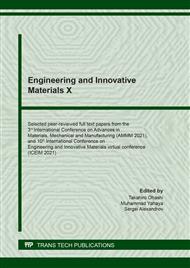p.15
p.23
p.29
p.35
p.41
p.49
p.57
p.67
p.73
Effect of Die Edge Roundness on Crack Initiation near Punch Edge in Blanking
Abstract:
In this study, the effect of die edge radius on crack initiation was discussed in finish blanking. Experiments were carried out using die with rounded cutting edge. As a result, it was confirmed that crack initiation near the punch edge occurred earlier than that near the die edge. It was also confirmed that the burnished surface increased with an increase in the die edge radius. Finite element method was carried out from the initial stage of shearing and until the punch penetration depth was achieved just before the occurrence of the cracks to investigate the distribution of the mean stress. As a result, it was confirmed that the punch stroke, where the mean stress began to increase rapidly to a positive value, increased with an increase in the die edge radius, and the punch stroke at which the mean stress increased rapidly also increased.
Info:
Periodical:
Pages:
41-46
Citation:
Online since:
April 2022
Authors:
Price:
Сopyright:
© 2022 Trans Tech Publications Ltd. All Rights Reserved
Share:
Citation:


